
Turkeys are large birds (the eighth largest living bird species in terms of maximum mass) native originally to the Americas, but after European colonization turkeys were transported to Europe and today they are a common livestock in Europe, America, and many other part of the world . They are raised for their meat all year round but are closely associated in America as the star of the yearly Thanksgiving Dinner.
Female domesticated turkeys are referred to as hens, and the chicks may be called poults or turkeylings. In the United States, the males are referred to as toms, while in Europe, males are stags. Male Turkeys are more colorful than female turkeys and have a distinctive fleshy wattle or protuberance that hangs from the top of the beak (called a snood).
Breeds of Turkeys
There are the following breeds of Turkeys:
|
 Auburn Auburn
|
|
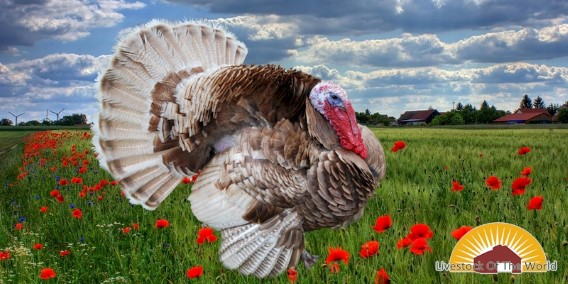
|
The Auburn turkey, also referred to as the Light Brown, stands as one of the most elusive and cherished varieties within the turkey kingdom. As a heritage breed, it embodies a lineage steeped in historical significance, preserving traits long forgotten in the modern domestic turkey landscape.
Originating in the northeastern United States, the Auburn turkey traces its roots back to the late 1700s, a testament to its enduring legacy in A
...
|
|
 Beltsville Small White Beltsville Small White
|
|
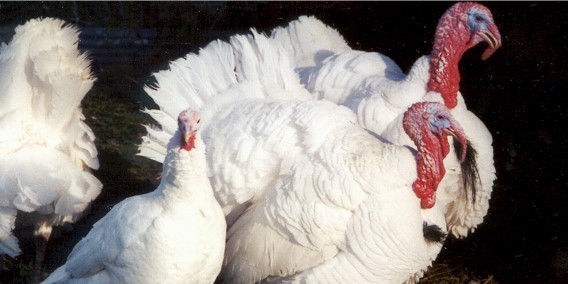
|
The
Beltsville Small White turkey is named after the USDA research center in
Beltsville Maryland where it was developed in the late 1930’s. At the time
consumers wanted a bird between 8 and 15 pounds that had a larger proportion of
breast meat than what had been available.After crossing many breeds an acceptable turkey was developed. The
variety was very popular with home cooks, but as refrigerators became larger
and the demand for even mor
...
|
|
 Black Black
|
|
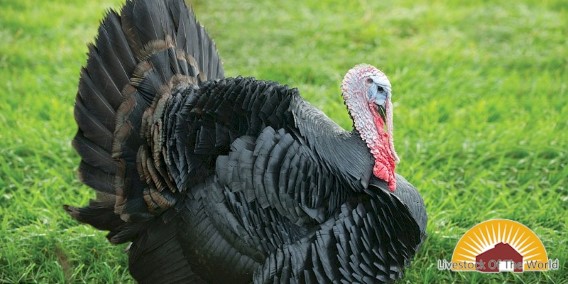
|
Black Turkeys, sometimes
referred to as Black Spanish Turkeys or Norfolk Black Turkeys, were developed
in Europe from a group of Aztec turkeys brought from Mexico in the 1500's. Today
they are found throughout Europe and are considered the oldest turkey breed in
the UK.
Black Turkeys have a
lustrous greenish-black plumage.
Black Turkeys were sent
in the holds of ships on the transatlantic crossing from Europe to the N
...
|
|
 Bourbon Red Bourbon Red
|
|
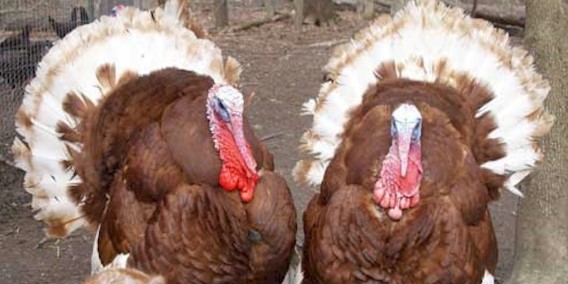
|
Bourbon Red Turkeys, also known as Kentucky
Red and Bourbon Butternut Turkeys, were developed in Bourbon
County Kentucky, US in the late 1800's. They were developed by J. F. Barbee who
crossbred Buff, Bronze, and White Holland Turkeys.
Bourbon Red Turkeys have a light-gray beak, red to blueish
wattles, a black beard, and pink legs and toes. Toms weigh around 23 lbs and
hens weigh around14 lbs. They lay large potted cream and brow
...
|
|
 Broad-breasted white Broad-breasted white
|
|
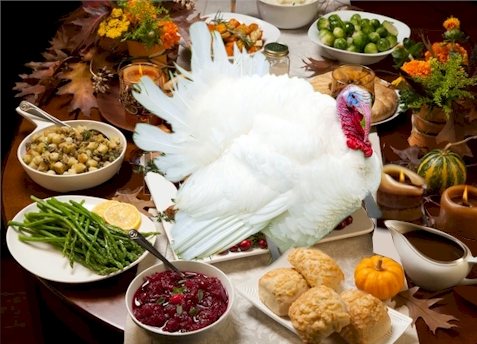
|
Broad-breasted white turkeys are the most commonly raised turkey. Mostly likely any turkey you eat on Thanksgiving, or any other time, is a Broad-Breasted white turkey.
Like most commercially raised livestock, they are popular because they are big and efficient. They have the maximum conversion ratio of feed to meat in the shortest possible time (like broiler chicken breeds). However, they are not considered as tasty as other turkeys
...
|
|
 Bronze Bronze
|
|

|
Bronze Turkeys,
also known as Cambridge Bronze Turkeys, are domestic turkey whose plumage has
an iridescent bronze-like sheen.
Bronze turkeys were developed by crossing domestic turkeys
brought from England, with wild turkeys. These matings produced a bird that was
larger and more robust than the European turkeys, and tamer than wild turkeys. Although
Bronze turkeys were created in the 18th century, the actual name was not used
u
...
|
|
 Buff Buff
|
|
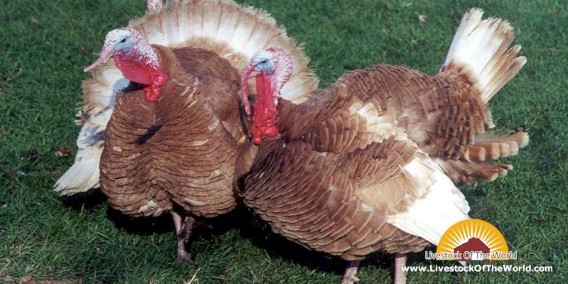
|
Buff Turkeys, also known as Jersey Buff Turkeys, are named for their buff-colored plumage, unsurprisingly.
Buff Turkeys were accepted into the Standard of Perfection
by the American Poultry Association in 1874, but had died out entirely by the
early 20th century. This was partly due to the difficulty in selectively
breeding the proper color pattern, and also to the rise of new commercial
breeds on the market.
In the 1940
...
|
|
 Dindon de Sologne Dindon de Sologne
|
|

|
Dindon de Sologne Turkeys (also known as the Black Turkey of Sologne, Black Sologne,turkey Sologne,orsolognot)are
a medium-sized variety of French Turkey with black plumage and blue-black legs.
Dindon de Sologne Turkeys are hardy birds with a strong bright-red
head, large, well-stocked wattles, a strong beak, bright eyes, a long neck, and
a dense, broad chest. They are good layer (on
average 15 eggs).
|
|
 Dindon Du Bourbonnais Dindon Du Bourbonnais
|
|
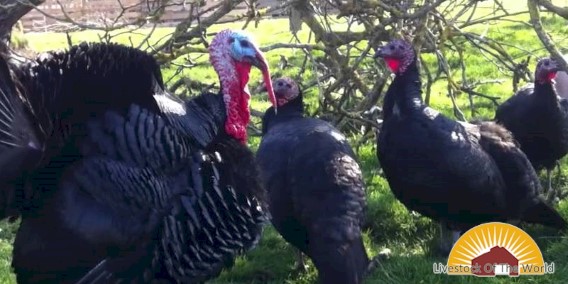
|
The Dindon Du Bourbonnais looks very much like the Sologne Black although it is more elegant. It is a vigorous turkey which carries itself proudly. It is lively and fiery. Its plumage is deep black with a metallic but not bronze highlight (very light bronze is tolerated in the tail cover feathers). Its black tarsus becomes clear even pink with age. The male weighs 10 to 12 kg, the female 7 to 9 kg.
|
|
 Dindon du Gers Dindon du Gers
|
|
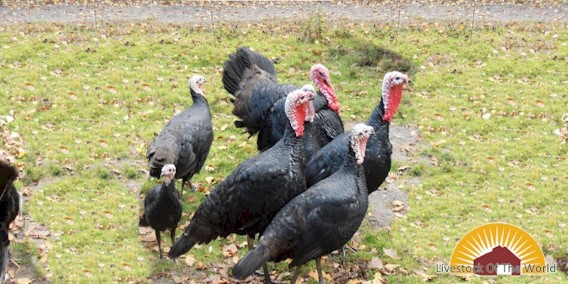
|
Dindon du Gers, or the French Black Turkey, is a large bird
with black plumage with beautiful bronzer, green, and brown tones on its back.
The Hens are reliable brooders and are willing to take care
of the poults of other hens.
Gers Turkeys are rare and in danger of extinction.
|
|
 Dindon rouge des Ardennes Dindon rouge des Ardennes
|
|
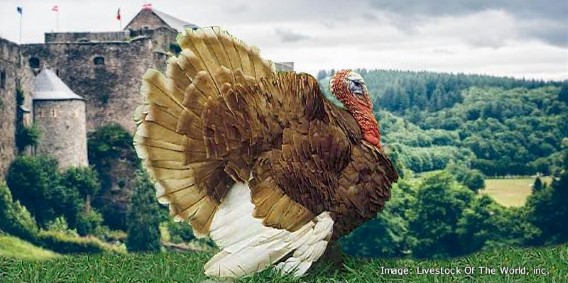
|
Dindon rouge des Ardennes Turkeys, or the red Turkey
Ardennes, first arrive in the Ardennes to the 16th century.
Dindon rouge des Ardennes Turkeys were popular for a long
time in the Ardennes. For example, it was one of the most famous dishes served when
Charles IX , celebrated his wedding to Elisabeth of Austria. However, over time
it has become less popular and almost became extinct.
In 1985 Jean-Michel Devress decide
...
|
|
 Ermellinato di Rovigo Ermellinato di Rovigo
|
|

|
Ermellinato di Rovigo Turkeys are from Veneto,
a region of northern Italy. They were derived from a mutation in the offspring
of crosses of local birds to American Narraganset Turkeys in 1958. But it was
good mutation and they were then selected for increased performance. The
Ermellinato di Rovigo is very rustic and well suited to pasture production.
They mature at 7 months and feather early.
They produce 70-100 eggs / year. The e
...
|
|
 Midget White Midget White
|
|
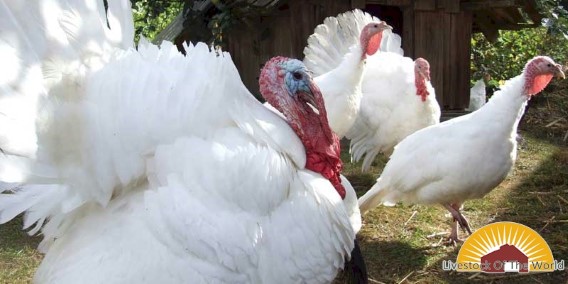
|
Midget White Turkeys are massively large black bird. Just
kidding, they actually are small and white, of course. They are the smallest
standard variety of turkey, toms weight
around 13 lbs and hens weight 8-10 lbs. Honestly they are only the size of a chicken!
Midget white turkeys were developed in the 1960s by Dr. J.
Robert Smyth at the University of Massachusetts Amherst. But there was not the
expected demand for small turkeys a
...
|
|
 Narragansett Narragansett
|
|
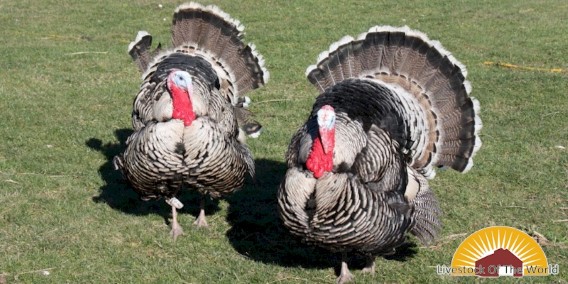
|
Narragansett Turkeys are a cross between
eastern American wild turkeys and domestic turkeys. They are unique to North
America and are named for Narragansett Bay, Rhode Island, US. They are raised for
commercial agriculture across the United States. They are the foundation of the turkey industry
in New England, US, and are especially important in Rhode Island and Connecticut.
They are also popular in the Mid-Atlantic States and the Midwest.
...
|
|
 Nero D Italia Nero D Italia
|
|

|
Nero D'Italia Turkeys were
developed by a group of breeders from Lombary Italy. It is believed that they
were developed from French Noir de Sologne Turkeys.
Nero D'Italia Turkeys are
small turkeys with iridescent black plumage. Males weight4-6 kg,
females weight 2,5-3,5 kg.
Content and Photo Source:
Agraria.org.
|
|
 Parma e Piacenza Parma e Piacenza
|
|

|
Parma e Piacenza Turkeys
are from the provinces of Parma and Piacenza, Italy. Their coloring is very
similar to Narragansett and d'Osca Turkeys.
Content and Photo Source: Agraia.org.
|
|
 Royal Palm Royal Palm
|
|
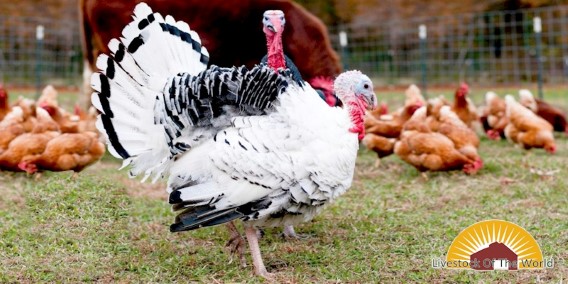
|
Royal Palm Turkeys are a breed of Turkey best known as an
ornamental bird with a unique appearance, largely white with bands of metallic
black.
Royal Palm Turkeys first appeared in the 1920s on a farm in
Lake Worth, Florida, apparently as a cross between Black, Bronze, Narragansett,
and native turkeys. After years of selective breeding the Royal Palm was
finally accepted by the American Poultry Association's Standard of Perfectio
...
|
|
 Slate Turkey Slate Turkey
|
|
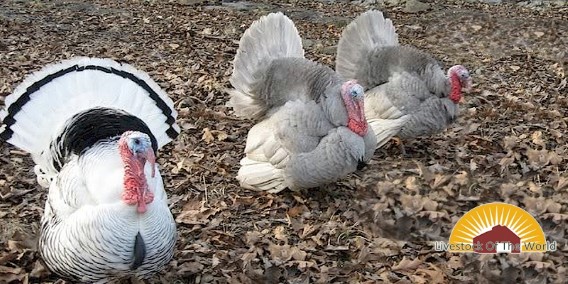
|
The Slate Turkey, also known as the American Blue or
Lavender Turkey, is variety of turkey that is
ashy blue over the entire body, sometimes with a few black flecks.The slate coloring is theresult of a combination of mutation (one
dominant and one recessive) .
The Slate variety was
accepted by the American Poultry Association in 1874. It has been popular in
exhibition circles and is gaining popularity in pastured poultry productio
...
|
|
 Sologne Black Sologne Black
|
|
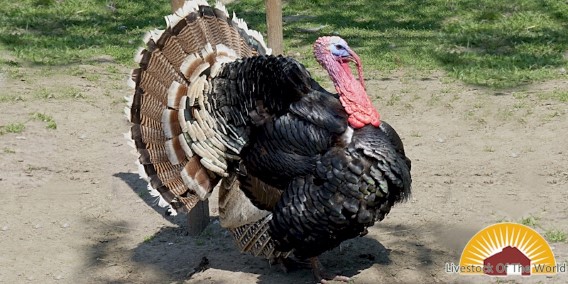
|
Looks very much like the Sologne Black although it is more
elegant. It is a vigorous turkey which carries itself proudly. It is lively and
fiery. Its plumage is deep black with a metallic but not bronze highlight (very
light bronze is tolerated in the tail cover feathers). Its black tarsus becomes
clear even pink with age. The male weighs 10 to 12 kg, the female 7 to 9 kg.
|
|
 Tacchino Castano d Italia Tacchino Castano d Italia
|
|

|
Tacchino Castano d'Italia Turkeys are very rare brown Italian turkeys. They
were selected by Prof. Raffaello Quilici at the Experimental Poultry
Observatory of Rovigo in 1960. They are almost extinct, but are being reconstituted
by Veneto Agriculture.
Their eggshell is slightly rosy and the eggs weigh 70-85 g. They
mature at seven year old. They are medium-large
(males weight 12-14 kg, females weight 5-7 kg). They have a dark brow
...
|
|
 White Holland White Holland
|
|

|
White Holland Turkeys are an old variety of domestic white
turkey. The White Holland originated from crosses of white European turkeys
imported to North America and crossed with native birds.
The White Holland was first recognized by the American
Poultry Association in 1874, and today is considered a heritage turkey breed. They are currently listed as threatened by The
Livestock Conservancy.
|

